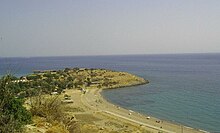Lebedus
Λέβεδος Template:Grc icon | |
 Lebedos was located on and around the Kısık Peninsula. | |
| Alternative name | Lebedos |
|---|---|
| Location | Ürkmez, Izmir Province, Turkey |
| Region | Ionia |
| Type | Settlement |
Lebedus or Lebedos (Template:Lang-grc) was one of the twelve cities of the Ionian League, located south of Smyrna, Klazomenai and neighboring Teos and before Ephesus, which is further south. It was on the coast, ninety stadia (16.65 km) to the east of Cape Myonnesus, and 120 (22.2 km) west of Colophon.
The city was built on and around a very small peninsula (175 m long, reaching a height of 61 m and with an isthmus 201 m wide), which is called the Kısık Peninsula today and depends on the coastal township of Ürkmez, part of Seferihisar locality, a district center depending on the province seat of İzmir.
The bishopric of Lebedus, a suffragan of Ephesus, is included in the Catholic Church's list of titular sees.[1]
History
According to Pausanias, the town was inhabited by Carians when the Ionian Greeks immigrated there under the guidance of Andræmon, a son of Codrus. Strabo, however, states that it was colonized by Andropompus and that it previously bore the name of Artis in Lydia. Lebedos became a flourishing city thanks to its commerce, and was famous for its mineral springs. But it was one of the smaller cities of the Ionian League, handicapped by the limited space of its hinterland and a comparatively unsuitable port.
In the Hellenistic age, around 304 BC, Antigonus I Monophthalmus tried to join the city with Teos; however, this operation was incomplete and eventually annulled by Lysimachus, who moved its population to Ephesus in 292 BC.
Under Roman rule, it flourished anew, becoming the meeting place of the actors of all Ionia when these were temporarily exiled from Teos, and festivals were celebrated in honour of Dionysus.
Its scanty remains are near the modern town of Seferihisar.
Lebedus appears in Notitiæ episcopatum as an episcopal see, suffragan of Ephesus until the 12th and 13th centuries. Three bishops only are known: Cyriacus, who witnessed the Second Council of Ephesus in 449; Julian, represented by his metropolitan at the Council of Chalcedon in 451; Theophanes or Thomas, who attended the Second Council of Nicæa in 787.
Sources
- George E. Bean. Aegean Turkey: An archaeological guide, p. 115-122 ISBN 978-0-510-03200-5, 1967. Ernest Benn, London.
 Herbermann, Charles, ed. (1913). "Lebedus". Catholic Encyclopedia. New York: Robert Appleton Company.
Herbermann, Charles, ed. (1913). "Lebedus". Catholic Encyclopedia. New York: Robert Appleton Company.
References
- ^ Annuario Pontificio 2013 (Libreria Editrice Vaticana, 2013, ISBN 978-88-209-9070-1), p. 914

